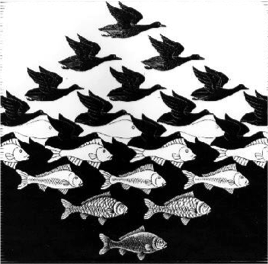

This course focuses on the relationship between salience and information theory. Salient,
relevant stimuli capture our attention, and the notion of salience has been widely employed
in linguistics (e.g. perceptual salience in the visual world, semantic-pragmatic salience of referents, acoustic salience). A different line of research accounts for language comprehension using information-theoretic notions, such as predictability and surprisal. Salience accounts and surprisal accounts focus on different aspects of comprehension. Surprisal accounts focus on the comprehender's expectations about what will follow next: high prediction error is associated with high cognitive load. Salience accounts on the other hand are concerned with the comprehender's attention, goal and situation.
We will review recent literature from linguistics and cognitive science on these issues and discuss if we can capture salience effects resorting only to the notion of predictability, if attention can be reduce to prediction, and how the two are related.
The course is open to students with background in linguistics as well
as students with background in psychology. The intention is for
students to profit from the diversity of backgrounds and knowledge,
through active discussion following the paper presentations.
Each week one or two students will pick one or two papers related to a topic or question, that they will present (20-30 min each presenter) to the rest of the
group. The students can decide themselves on the focus of the
presentation, based on the original research question and their
interests. Each student will choose one or two papers that the rest of the class
can read to prepare for their presentation.
During the first few weeks we will hold regular meetings in the form
of lectures, to lay the foundations that will help you understand
the papers, and bring students with different backgrounds up to a
common level of understanding.
The students will also have to participate in a peer review session. More information on intent and purpose of the peer review form will
be given during the introductory meeting.
MSc students can choose between a 4CP and 7CP version of the
course. For the 7CP version, students additionally need to write a
term paper. BSc students have to write the term paper.
| Date | Topic | Speaker | Discussion chair |
| 23.10. 3 p.m.! | Introduction to the Course, Administrative Information, Distribution of Topics | Vera Demberg, Alessandra Zarcone | |
| 30.10. | no meeting (SFB event) | ||
| 6.11. | Surprise Itti, L., & Baldi, P. (2009). Bayesian surprise attracts human attention. Vision research, 49(10). | reading group session | |
| 13.11. | Surprise Barto, A., Mirolli, M., & Baldassarre, G. (2013). Novelty or surprise? Frontiers in Psychology, 4, 1–15. | reading group session | |
| 20.11. | Feedback on Luigi's slides | ||
| 27.11. | Memory and Lexicon Geraci, L., McDaniel, M. A., Miller, T. M., & Hughes, M. L. (2013). The bizarreness effect: Evidence for the critical influence of retrieval processes. Memory & Cognition, 41(8), 1228–1237. | Luigi Palumbo | |
| 4.12. | no meeting | ||
| 11.12. 3.30 pm | Attentional deployment Awh, E., Belopolsky, A. V., & Theeuwes, J. (2012). Top-down versus bottom-up attentional control: a failed theoretical dichotomy. Trends in Cognitive Sciences, 16(8) AND Summerfield, C. & Egner, T. (2009). Expectation (and attention) in visual cognition. Trends in Cognitive Sciences 13. 403-409. |
reading group + abstract session | |
| 18.12. | no meeting | ||
| 08.01. | Neurolinguistic aspects Jensen, O., Bonnefond, M., & VanRullen, R. (2012). An oscillatory mechanism for prioritizing salient unattended stimuli. Trends in Cognitive Sciences, 16(4), 200-206. AND Klimesch, W. (2012). Alpha-band oscillations, attention, and controlled access to stored information. Trends in Cognitive Sciences, 16(12), 606-617 |
reading group session | |
| 15.01. | Acquisition / learning Kidd, C., Piantadosi, S. T., & Aslin, R. N. (2012). The Goldilocks effect: Human infants allocate attention to visual sequences that are neither too simple nor too complex. PloS one, 7(5) |
reading group session | |
| 22.01. | Counterpredictive gaze and arrow cues Friesen, C. K., Ristic, J., & Kingstone, A. (2004). Attentional effects of counterpredictive gaze and arrow cues. Journal of Experimental Psychology: Human Perception and Performance, 30(2), 319. AND Tipples, J. (2008). Orienting to counterpredictive gaze and arrow cues. Perception & Psychophysics, 70(1), 77-87. |
reading group session | |
| 29.01. | Attention and reference resolution Nappa, R., & Arnold, J. E. (2014). The road to understanding is paved with the speaker’s intentions: Cues to the speaker’s attention and intentions affect pronoun comprehension. Cognitive Psychology, 70, 58-81 AND Staudte, M., Crocker, M. W., Heloir, A., & Kipp, M. (2014). The influence of speaker gaze on listener comprehension: Contrasting visual versus intentional accounts. Cognition, 133(1), 317-328. |
reading group session | |
| 05.02. | no meeting (PhD Day) |
The papers mentioned here are some pointers to get you started. You can choose one of these papers, but you're also free to suggest other papers. Please contact us if you would like to present something that's not on this list.
Some papers are paired with another one. This is because they are shorter / easier than the others and should be presented together by the same presenter.